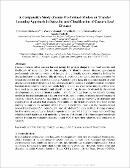| dc.contributor.author | Emmanuel, Ahishakiye | |
| dc.contributor.author | Waweru, Mwangi | |
| dc.contributor.author | Petronilla, Muthoni | |
| dc.contributor.author | Danison, Taremwa | |
| dc.contributor.author | Fredrick, Kanobe | |
| dc.date.accessioned | 2023-04-12T13:52:26Z | |
| dc.date.available | 2023-04-12T13:52:26Z | |
| dc.date.issued | 2022 | |
| dc.identifier.citation | Emmanuel, A., Mwangi, W., Muthoni, P., Danison, T., & Fredrick, K. A Comparative Study of Some Pre-Trained Models on Transfer Learning Approach in Detection and Classification of Cassava Leaf Diseases. Available at SSRN 4115549. | en_US |
| dc.identifier.uri | https://hdl.handle.net/20.500.12504/1300 | |
| dc.description.abstract | Cassava diseases affect cassava harvest posing the greatest danger to the food security and livelihoods of more than 200 million people. To identify cassava diseases, government professionals visit various sections of the country and visually score the plants by looking for disease indicators on the leaves. This procedure is notoriously subjective; it is not uncommon for specialists to differ on a plant's diagnosis. Automating the detection and classification of crop diseases could help professionals diagnose diseases more accurately and allow farmers in remote locations to monitor their crops without the help of specialists. Machine learning algorithms have been used in the early detection and classification of crop diseases. Motivated by the current developments and many influential studies in the field of deep learning and transfer learning models in the detection and classification of crop diseases, this study evaluates the performance of VGG16, VGG19, ResNet50, InceptionV3, DenseNet201, and MobileNetV2 in detection and classification of cassava leaf diseases. Fine-tuning of the hyperparameters was done during training to improve the accuracy of the models. Experimental results on the cassava dataset revealed that InceptionV3, DenseNet201, and MobileNetV2 models had high training accuracy but low validation accuracy with various epochs which means that they had issues with over fitting while ResNet50 had issues with underfitting. Moreso, VGG16 and VGG19 models performed well on both training and validation datasets, though VGG16 performed relatively well compared to VGG19. | en_US |
| dc.language.iso | en | en_US |
| dc.publisher | SSRN | en_US |
| dc.subject | Machine learning, | en_US |
| dc.subject | Transfer learning, | en_US |
| dc.subject | Cassava Diseases Classification | en_US |
| dc.subject | CNN. | en_US |
| dc.title | A comparative study of some pre-trained models on transfer learning approach in detection and classification of cassava leaf diseases | en_US |
| dc.type | Article | en_US |

